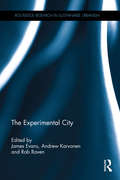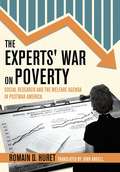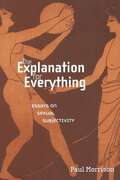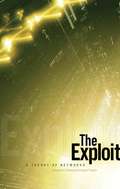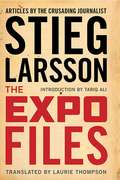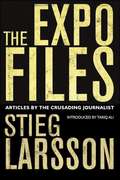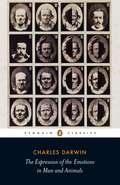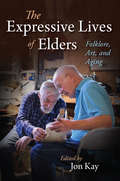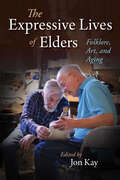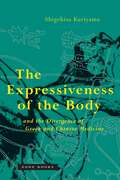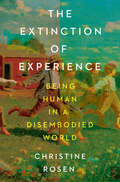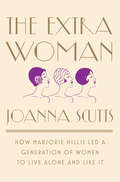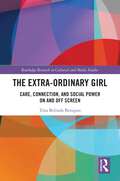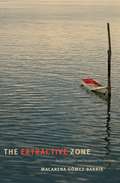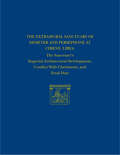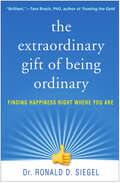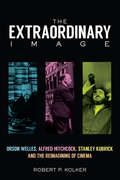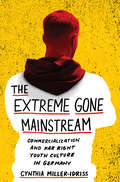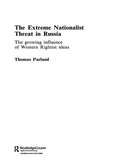- Table View
- List View
The Experimental City (Routledge Research in Sustainable Urbanism)
by James Evans, Andrew Karvonen and Rob RavenThis book explores how the concept or urban experimentation is being used to reshape practices of knowledge production in urban debates about resilience, climate change governance, and socio-technical transitions. With contributions from leading scholars, and case studies from the Global North and South, from small to large scale cities, this book suggests that urban experiments offer novel modes of engagement, governance, and politics that both challenge and complement conventional strategies. The book is organized around three cross-cutting themes. Part I explores the logics of urban experimentation, different approaches, and how and why they are deployed. Part II considers how experiments are being staged within cities, by whom, and with what effects? Part III examines how entire cities or groups of cities are constructed as experiments. This book seeks to contribute a deeper and more socially and politically nuanced understanding of how urban experiments shape cities and drive wider changes in society, providing a framework to examine the phenomenon of urban experimentation in conceptual and empirical detail.
The Expert Cook in Enlightenment France (The Johns Hopkins University Studies in Historical and Political Science #129)
by Sean TakatsIn the eighteenth-century French household, the servant cook held a special place of importance, providing daily meals and managing the kitchen and its finances. In this scrupulously researched and witty history, Sean Takats examines the lives of these cooks as they sought to improve their position in society and reinvent themselves as expert, skilled professionals.Much has been written about the cuisine of the period, but Takats takes readers down into the kitchen and introduces them to the men and women behind the food. It is only in that way, Takats argues, that we can fully recover the scientific and cultural significance of the meals they created, and, more important, the contributions of ordinary workers to eighteenth-century intellectual life. He shows how cooks, along with decorators, architects, and fashion merchants, drove France’s consumer revolution, and how cooks' knowledge about a healthy diet and the medicinal properties of food advanced their professional status by capitalizing on the Enlightenment’s new concern for bodily and material happiness. The Expert Cook in Enlightenment France explores a unique intersection of cultural history, labor history, and the history of science and medicine. Relying on an unprecedented range of sources, from printed cookbooks and medical texts to building plans and commercial advertisements, Takats reconstructs the evolving role of the cook in Enlightenment France. Academics and students alike will enjoy this fascinating study of the invention of the professional chef, of how ordinary workers influenced emerging trends of scientific knowledge, culture-creation, and taste in eighteenth-century France.
The Experts' War on Poverty: Social Research and the Welfare Agenda in Postwar America (American Institutions and Society)
by Romain D. HuretIn the critically acclaimed La Fin de la Pauverté?, Romain D. Huret identifies a network of experts who were dedicated to the post-World War II battle against poverty in the United States. John Angell's translation of Huret's work brings to light for an English-speaking audience this critical set of intellectuals working in federal government, academic institutions, and think tanks. Their efforts to create a policy bureaucracy to support federal socio-economic action spanned from the last days of the New Deal to the late 1960s when President Richard M. Nixon implemented the Family Assistance Plan. Often toiling in obscurity, this cadre of experts waged their own war not only on poverty but on the American political establishment. Their policy recommendations, as Huret clearly shows, often militated against the unscientific prejudices and electoral calculations that ruled Washington D.C. politics.The Experts' War on Poverty highlights the metrics, research, and economic and social facts these social scientists employed in their work, and thereby reveals the unstable institutional foundation of successive executive efforts to grapple with gross social and economic disparities in the United States. Huret argues that this internal war, coming at a time of great disruption due to the Cold War, undermined and fractured the institutional system officially directed at ending poverty. The official War on Poverty, which arguably reached its peak under President Lyndon B. Johnson, was thus fomented and maintained by a group of experts determined to fight poverty in radical ways that outstripped both the operational capacity of the federal government and the political will of a succession of presidents.
The Explanation For Everything: Essays on Sexual Subjectivity (Sexual Cultures #31)
by Paul Morrison"The claim 'I'm straight' is the psychosexual analogue of 'The check is in the mail': if you need to say it, your credit or creditability is already in doubt." So begins Paul Morrison's dazzling polemic, which takes as its point of departure Foucault's famous remark that sex is "the explanation for everything." Combining psychoanalytic, literary, and queer theory, The Explanation for Everything seeks to account for the explanatory power attributed to homosexuality, and its relationship to compulsory heterosexuality. In the process, Morrison presents a scathing indictment of psychoanalysis and its impact on the study of sexuality. In bold but graceful leaps, Morrison applies his critique to a diversity of examples: subjectivity in Oscar Wilde, the cultural construction and reception of AIDS, the work of Robert Mapplethorpe, the practice of bodybuilding, and the contemporary reception of the sexual politics of fascism. Analytical, witty and astute, The Explanation for Everything will challenge and amuse, establishing Paul Morrison as one of our most exciting cultural critics.
The Exploit: A Theory of Networks (Electronic Mediations #21)
by Alexander R. Galloway Eugene ThackerThe network has become the core organizational structure for postmodern politics, culture, and life, replacing the modern era&’s hierarchical systems. From peer-to-peer file sharing and massive multiplayer online games to contagion vectors of digital or biological viruses and global affiliations of terrorist organizations, the network form has become so invasive that nearly every aspect of contemporary society can be located within it.Borrowing their title from the hacker term for a program that takes advantage of a flaw in a network system, Alexander R. Galloway and Eugene Thacker challenge the widespread assumption that networks are inherently egalitarian. Instead, they contend that there exist new modes of control entirely native to networks, modes that are at once highly centralized and dispersed, corporate and subversive. In this provocative book-length essay, Galloway and Thacker argue that a whole new topology must be invented to resist and reshape the network form, one that is as asymmetrical in relationship to networks as the network is in relation to hierarchy.
The Explorations of Edmund Snow Carpenter: Anthropology Upside Down
by Richard CavellEdmund Snow Carpenter (1922–2011), shaped by an early encounter with Marshall McLuhan, was a renegade anthropologist who would plumb the connection between anthropology and media studies over a thoroughly unconventional career.As co-conspirators in the founding of the legendary journal Explorations (1953–59), Carpenter and McLuhan established the groundwork for media studies. After ten years teaching anthropology at the University of Toronto, hosting radio and television shows on the CBC, and doing major research in the Arctic, Carpenter left Toronto and became an itinerant anthropologist. He took up a position in Papua New Guinea, where he countered anthropological practice by handing his camera to the Papuans. Carpenter’s marriage to the artist and heiress Adelaide de Menil made him a truly independent scholar. With the support of the Rock Foundation, founded by de Menil, he collected ethnographical art, curated exhibitions, and edited the materials for a twelve-volume study of social symbolism based on the massive archives created by Carl Schuster. Richard Cavell shows Carpenter – austere, generous, and unpredictable – to also be unwavering in working throughout his career within the framework established by Explorations.The anthropological impetus for media studies has largely been forgotten. This study restores that memory, tracing Carpenter’s work in media and in anthropology over a lifetime of cultural achievements and intellectual convolutions.
The Expo Files
by Tariq Ali Laurie Thompson Stieg LarssonNow almost exclusively known as the author of the bestselling Millennium Trilogy, Stieg Larsson was first and foremost a professional journalist and an untiring crusader for democracy and equality.Collected in English for the first time, the articles in this volume explore the human rights issues that formed the ideological foundation of his explosive trio of novels. Before he ever began his cycle of novels about the travails of Mikael Blomkvist and Lisbeth Salander, Stieg Larsson used the pulpit of the media to denounce right-wing extremism throughout Europe. A co-founder of the influential journal EXPO and its primary editor for many years, Larsson spoke out passionately against many of the worst crimes against women, minorities, and other disenfranchised communities. These unflinching articles showcase Larsson's spare style and sly humor as he dissects many instances of persistent anti-humanist behavior and politics. Written with the urgency and economy of someone who knew that there is no time to waste when it comes to fighting the forces of bigotry, sexism, and racism, The EXPO Files is required reading not just for fans of the Millennium Trilogy, but everyone who applauds writers with the courage to denounce evil when they see it. From the Hardcover edition.
The Expo Files: Articles by the Crusading Journalist
by Stieg LarssonNow almost exclusively known as the author of the bestselling Millennium Trilogy, as a professional journalist Stieg Larsson was an untiring crusader for democracy and equality. As a reporter and editor-in-chief on the journal Expo he researched the extreme right both in Sweden and at an international level. Collected here for the first time are essays and articles on right-wing extremism and racism, on violence against women and women's rights, on homophobia and honour killings. Larsson never ceased to fight for and write about his most firmly held principles; it was his commitment to these which gave his best-selling novels their explosive force.
The Expo Files: Articles by the Crusading Journalist
by Stieg LarssonNow almost exclusively known as the author of the bestselling Millennium Trilogy, as a professional journalist Stieg Larsson was an untiring crusader for democracy and equality. As a reporter and editor-in-chief on the journal Expo he researched the extreme right both in Sweden and at an international level. Collected here for the first time are essays and articles on right-wing extremism and racism, on violence against women and women's rights, on homophobia and honour killings. Larsson never ceased to fight for and write about his most firmly held principles; it was his commitment to these which gave his best-selling novels their explosive force.
The Expression of the Emotions in Man and Animals: The Expression Of The Emotions In Man And Animals (Cambridge Library Collection - Darwin, Evolution And Genetics Ser.)
by Charles DarwinPublished in 1872, The Expression of the Emotions in Man and Animals was a book at the very heart of Darwin's research interests - a central pillar of his 'human' series. This book engaged some of the hardest questions in the evolution debate, and it showed the ever-cautious Darwin at his boldest. If Darwin had one goal with Expression, it was to demonstrate the power of his theories for explaining the origin of our most cherished human qualities: morality and intellect. As Darwin explained, "He who admits, on general grounds, that the structure and habits of all animals have been gradually evolved, will look at the whole subject of Expression in a new and interesting light."
The Expressive Lives of Elders: Folklore, Art, and Aging (Material Vernaculars)
by Jon KayCan traditional arts improve an older adult’s quality of life? Are arts interventions more effective when they align with an elder’s cultural identity? In The Expressive Lives of Elders, Jon Kay and contributors from a diverse range of public institutions argue that such mediations work best when they are culturally, socially, and personally relevant to the participants. From quilting and canning to weaving and woodworking, this book explores the role of traditional arts and folklore in the lives of older adults in the United States, highlighting the critical importance of ethnographic studies of creative aging for both understanding the expressive lives of elders and for designing effective arts therapies and programs. Each case study in this volume demonstrates how folklore and traditional practices help elders maintain their health and wellness, providing a road map for initiatives to improve the lives and well-being of America’s aging population.
The Expressive Lives of Elders: Folklore, Art, and Aging (Material Vernaculars)
by Jon KayEssays examining the power of traditional arts and folklore in the lives of the elderly in the United States.Can traditional arts improve an older adult’s quality of life? Are arts interventions more effective when they align with an elder’s cultural identity? In The Expressive Lives of Elders, Jon Kay and contributors from a diverse range of public institutions argue that such mediations work best when they are culturally, socially, and personally relevant to the participants.From quilting and canning to weaving and woodworking, this book explores the role of traditional arts and folklore in the lives of older adults in the United States, highlighting the critical importance of ethnographic studies of creative aging for both understanding the expressive lives of elders and for designing effective arts therapies and programs. Each case study in this volume demonstrates how folklore and traditional practices help elders maintain their health and wellness, providing a road map for initiatives to improve the lives and well-being of America’s aging population.
The Expressive Moment: How Interaction (with Music) Shapes Human Empowerment
by Marc LemanA new way to understand expressive interaction, focusing on the dynamic, fast, pre-reflective processes underlying interactions with music.The expressive moment is that point in time when we grasp a situation and respond quickly, even before we are aware of it. In this book, Marc Leman argues that expression drives this kind of interaction, and he proposes a general framework for understanding expressive interactions. He focuses on the dynamic, fast, and pre-reflective processes underlying our interactions with music—whether we are playing an instrument, dancing, listening, or using new interactive technologies. Music offers a well-established domain for studying these fast and interactive processes, and Leman argues that understanding the power of expressive interaction through music may help us understand cognitive processing in other domains, including language, human action coordination, human-animal interaction, and human-machine interaction.Leman regards expressive interactions with music as energizing and empowering. He argues that music is based on patterns that intervene with a reinforcing loop in the human brain, strengthening learning, motivation, and reward. He argues further that the reinforcing effect is influenced by the interaction flow, by fast processes that handle expressive qualities on the fly.Leman sets out the framework in which expressive interaction is situated, describing, among other things, a pragmatic model of communication in which the fundamental components are enactment and dynamics. He looks in more detail at the cognitive-motivational architecture, discussing sensorimotor and motivational schemes. Finally, he discusses applications for the concepts behind expressive motivation in such fields as sports, entertainment, rehabilitation, multimedia art, and music education.
The Expressiveness of the Body and the Divergence of Greek and Chinese Medicine
by Shigehisa KuriyamaAn illuminating account of how early medicine in Greece and China perceived the human bodyWinner of the William H. Welch Medal, American Association for the History of MedicineThe true structure and workings of the human body are, we casually assume, everywhere the same, a universal reality. But when we look into the past, our sense of reality wavers: accounts of the body in diverse medical traditions often seem to describe mutually alien, almost unrelated worlds. How can perceptions of something as basic and intimate as the body differ so? In this book, Shigehisa Kuriyama explores this fundamental question, elucidating the fascinating contrasts between the human body described in classical Greek medicine and the body as envisaged by physicians in ancient China. Revealing how perceptions of the body and conceptions of personhood are intimately linked, his comparative inquiry invites us, indeed compels us, to reassess our own habits of feeling and perceiving.
The Exquisite Corpse of Asian America: Biopolitics, Biosociality, and Posthuman Ecologies (Sexual Cultures #16)
by Rachel C. LeeWinner of the 2016 Association for Asian American Studies Award for Best Book in Cultural StudiesThe Exquisite Corpse ofAsian Americaaddresses this central question: if race has been settled as a legal or socialconstruction and not as biological fact, why do Asian American artists,authors, and performers continue to scrutinize their body parts? Engagingnovels, poetry, theater, and new media from both the U.S. andinternationally—such as Kazuo Ishiguro’s science fiction novel Never Let MeGo or Ruth Ozeki’s My Year of Meats and exhibits like that of BodyWorlds in which many of the bodies on display originated from Chinese prisons—RachelC. Lee teases out the preoccupation with human fragments and posthumanecologies in the context of Asian American cultural production and theory. Sheunpacks how the designation of “Asian American” itself is a mental constructthat is paradoxically linked to the biological body.Through chapters that each use a body part as springboard forreading Asian American texts, Lee inaugurates a new avenue of research onbiosociality and biopolitics within Asian American criticism, focused on theliterary and cultural understandings of pastoral governmentality, the divergentscales of embodiment, and the queer (cross)species being of racial subjects.She establishes an intellectual alliance and methodological synergy betweenAsian American studies and Science and Technology Studies (STS), biocultures,medical humanities, and femiqueer approaches to family formation, carework,affect, and ethics. In pursuing an Asian Americanist critique concerned withspeculative and real changes to human biologies, she both produces innovationwithin the field and demonstrates the urgency of that critique to otherdisciplines.
The Extended Reality Blueprint: Demystifying the AR/VR Production Process
by Annie EatonFollow a tried-and-tested approach to integrating augmented and virtual reality into your business The Extended Reality Blueprint focuses on design for non-gaming or gaming adjacent applications in extended reality (XR), including augmented and virtual reality. Author Annie Eaton is a leading producer of immersive content in the XR space. Many of Annie's clients come to her with the same questions, often not knowing where to begin as they seek to implement extended reality solutions into their business. This book presents the discovery and product development process through an immersive technology lens. You will walk through the XR production process and learn how to apply this technology directly within your organizations in a meaningful and effective way. Join leading businesses like Delta Air Lines, Mars Wrigley, Georgia-Pacific, and JLG Industries, and learn how top companies are leveraging XR for greater market share, engagement, and profit. Learn about the latest applications of extended reality (XR), including augmented and virtual reality. Discover the steps of the XR product development process, including how to find profitable uses of XR and decide on technology suites. Assemble effective teams of XR developers, designers, artists, and other key members to bring your projects to fruition and success. Learn from the real-world examples and lessons learned of businesses that have taken the leap into extended reality. The Extended Reality Blueprint, delivers a concrete, actionable process for brining extended reality into your organization and embracing this crucial technology to remain current.
The Extinction of Experience: Being Human in a Disembodied World
by Christine RosenA reflective, original invitation to recover and cultivate the human experiences that have atrophied in our virtual world. We embraced the mediated life—from Facetune and Venmo to meme culture and the Metaverse—because these technologies offer novelty and convenience. But they also transform our sense of self and warp the boundaries between virtual and real. What are the costs? Who are we in a disembodied world? In The Extinction of Experience, Christine Rosen investigates the cultural and emotional shifts that accompany our embrace of technology. In warm, philosophical prose, Rosen reveals key human experiences at risk of going extinct, including face-to-face communication, sense of place, authentic emotion, and even boredom. Considering cultural trends, like TikTok challenges and mukbang, and politically unsettling phenomena, like sociometric trackers and online conspiracy culture, Rosen exposes an unprecedented shift in the human condition, one that habituates us to alienation and control. To recover our humanity and come back to the real world, we must reclaim serendipity, community, patience, and risk.
The Extra Woman: How Marjorie Hillis Led A Generation Of Women To Live Alone And Like It
by Joanna ScuttsFrom the flapper to The Feminine Mystique, a cultural history of single women in the city through the reclaimed life of glamorous guru Marjorie Hillis. You’ve met the extra woman: she’s sophisticated, she lives comfortably alone, she pursues her passions unabashedly, and—contrary to society’s suspicions—she really is happy. Despite multiple waves of feminist revolution, today’s single woman is still mired in judgment or, worse, pity. But for a brief, exclamatory period in the late 1930s, she was all the rage. A delicious cocktail of cultural history and literary biography, The Extra Woman transports us to the turbulent and transformative years between suffrage and the sixties, when, thanks to the glamorous grit of one Marjorie Hillis, single women boldly claimed and enjoyed their independence. Marjorie Hillis, pragmatic daughter of a Brooklyn preacher, was poised for reinvention when she moved to the big city to start a life of her own. Gone were the days of the flirty flapper; ladies of Depression-era New York embraced a new icon: the independent working woman. Hillis was already a success at Vogue when she published a radical self-help book in 1936: Live Alone and Like It: A Guide for the Extra Woman. With Dorothy Parker–esque wit, she urged spinsters, divorcées, and “old maids” to shed derogatory labels and take control of their lives, and her philosophy became a phenomenon. From the importance of a peignoir to the joy of breakfast in bed (alone), Hillis’s tips made single life desirable and chic. In a style as irresistible as Hillis’s own, Joanna Scutts, a leading cultural critic, explores the revolutionary years following the Live-Alone movement, when the status of these “brazen ladies” peaked and then collapsed. Other innovative lifestyle gurus set similar trends that celebrated guiltless female independence and pleasure: Dorothy Draper’s interior design smash, Decorating Is Fun! transformed apartments; Irma Rombauer’s warm and welcoming recipe book, The Joy of Cooking, reassured the nervous home chef that she, too, was capable of decadent culinary feats. By painting the wider picture, Scutts reveals just how influential Hillis’s career was, spanning decades and numerous best sellers. As she refashioned her message with every life experience, Hillis proved that guts, grace, and perseverance would always be in vogue. With this vibrant examination of a remarkable life and profound feminist philosophy, Joanna Scutts at last reclaims Marjorie Hillis as the original queen of a maligned sisterhood. Channeling Hillis’s charm, The Extra Woman is both a brilliant exposé of women who forged their independent paths before the domestic backlash of the 1950s trapped them behind picket fences, and an illuminating excursion into the joys of fashion, mixology, decorating, and other manifestations of shameless self-love.
The Extra-Ordinary Girl: Care, Connection, and Social Power On and Off Screen (Routledge Research in Cultural and Media Studies)
by Tina Belinda BenignoPositioning the teen girl as a figure possessing exceptional power with the potential to instigate change, this book examines the “extra-ordinary” girl as she exists under neoliberalism today.Through a combination of textual and cultural analyses of figurations of girlhood in popular culture, and qualitative research group interviews with teen girls, the author emphasizes the importance of listening to real teen girls whose perspectives and values might not match those attributed to dominant cultural models of girlhood. This book explores contemporary girl figures and figurations of girlhood, on and off screen, highlighting how girls who are not in the public eye negotiate standards of exceptionality in relation to their own experiences of social power, while also defining the importance of care and connection to their relationships and personal values.This book is a unique and comprehensive combination of methodological and conceptual approaches to cultural, historical, and sociological analyses, while exploring questions of feminism and the speculative fiction genre. It will appeal to girlhood and feminist studies, film and media studies, child and youth studies, humanities, cultural studies, and social sciences.
The Extractive Zone: Social Ecologies and Decolonial Perspectives
by Macarena Gómez-BarrisIn The Extractive Zone Macarena Gómez-Barris traces the political, aesthetic, and performative practices that emerge in opposition to the ruinous effects of extractive capital. The work of Indigenous activists, intellectuals, and artists in spaces Gómez-Barris labels extractive zones—majority indigenous regions in South America noted for their biodiversity and long history of exploitative natural resource extraction—resist and refuse the terms of racial capital and the continued legacies of colonialism. Extending decolonial theory with race, sexuality, and critical Indigenous studies, Gómez-Barris develops new vocabularies for alternative forms of social and political life. She shows how from Colombia to southern Chile artists like filmmaker Huichaqueo Perez and visual artist Carolina Caycedo formulate decolonial aesthetics. She also examines the decolonizing politics of a Bolivian anarcho-feminist collective and a coalition in eastern Ecuador that protects the region from oil drilling. In so doing, Gómez-Barris reveals the continued presence of colonial logics and locates emergent modes of living beyond the boundaries of destructive extractive capital.
The Extramural Sanctuary of Demeter and Persephone at Cyrene, Libya, Final Reports, Volume VIII: The Sanctuary's Imperial Architectural Development, Conflict with Christianity, and Final Days
by Donald WhiteThis is the climactic volume on the archaeological and architectural history from ca. 31 B.C. to A.D. 365 of the extramural sanctuary of Demeter and Persephone at Cyrene, Libya. It deals with the impact of Christianity on the cult and the causes of its decline, with particular emphasis on the largest body of evidence recorded anywhere for iconoclastic damage, presumably by Christian populations, to sculpted images of worshippers and twin goddesses. The volume traces the characteristics of major Demeter sanctuaries elsewhere (e.g., Eleusis, Corinth, Pergamon, Acragas, and Selinus) and places Cyrene's sanctuary within the context of this development.The volume also presents the sanctuary's important lapidary and lead inscriptions as analyzed by Joyce Reyonlds. It is the eighth volume in the final reports series for the excavations conducted for the University of Michigan, and subsequently the University of Pennsylvania Museum of Archaeology and Anthropology, between 1969 and 1981.University Museum Monograph, 134
The Extraordinary Gift of Being Ordinary: Finding Happiness Right Where You Are
by Ronald D. Siegel&“Did I sound stupid?&” &“Should I have sent that email?&” &“How do I look?&” Many of us spend a lot of time feeling self-conscious and comparing ourselves to others. Why do we judge ourselves so relentlessly? Why do we strive so hard to be special or successful, or to avoid feeling rejected? When psychologist and mindfulness expert Dr. Ronald Siegel realized that he, as well as most of his clients, was caught in a cycle of endless self-evaluation, he decided to do something about it. This engaging, empowering guide sheds light on this very human habit/m-/and explains how to break it. Through illuminating stories and exercises, practical tools (which you can download and print for repeated use), and guided meditations with accompanying audio downloads, Dr. Siegel invites you to stop obsessing so much about how you measure up. Instead, by accepting the extraordinary gift of being ordinary, you can build stronger connections with others and get more joy out of life.
The Extraordinary Image: Orson Welles, Alfred Hitchcock, Stanley Kubrick, and the Reimagining of Cinema
by Robert P. KolkerWelles. Hitchcock. Kubrick. These names appear on nearly every list of the all-time greatest filmmakers. But what makes these directors so great? Despite their very different themes and sensibilities, is there a common genius that unites them and elevates their work into the realm of the sublime? The Extraordinary Image takes readers on a fascinating journey through the lives and films of these three directors, identifying the qualities that made them cinematic visionaries. Reflecting on a lifetime of teaching and writing on these filmmakers, acclaimed film scholar Robert P. Kolker offers a deeply personal set of insights on three artists who have changed the way he understands movies. Spotlighting the many astonishing images and stories in films by Welles, Hitchcock, Kubrick, he also considers how they induce a state of amazement that transports and transforms the viewer. Kolker's accessible prose invites readers to share in his own continued fascination and delight at these directors' visual inventiveness, even as he lends his expertise to help us appreciate the key distinctions between the unique cinematic universes they each created. More than just a celebration of three cinematic geniuses, The Extraordinary Image is an exploration of how movies work, what they mean, and why they bring us so much pleasure.
The Extreme Gone Mainstream: Commercialization and Far Right Youth Culture in Germany
by Cynthia Miller-IdrissHow extremism is going mainstream in Germany through clothing brands laced with racist and nationalist symbolsThe past decade has witnessed a steady increase in far right politics, social movements, and extremist violence in Europe. Scholars and policymakers have struggled to understand the causes and dynamics that have made the far right so appealing to so many people—in other words, that have made the extreme more mainstream. In this book, Cynthia Miller-Idriss examines how extremist ideologies have entered mainstream German culture through commercialized products and clothing laced with extremist, anti-Semitic, racist, and nationalist coded symbols and references.Drawing on a unique digital archive of thousands of historical and contemporary images, as well as scores of interviews with young people and their teachers in two German vocational schools with histories of extremist youth presence, Miller-Idriss shows how this commercialization is part of a radical transformation happening today in German far right youth subculture. She describes how these young people have gravitated away from the singular, hard-edged skinhead style in favor of sophisticated and fashionable commercial brands that deploy coded extremist symbols. Virtually indistinguishable in style from other popular clothing, the new brands desensitize far right consumers to extremist ideas and dehumanize victims.Required reading for anyone concerned about the global resurgence of the far right,The Extreme Gone Mainstream reveals how style and aesthetic representation serve as one gateway into extremist scenes and subcultures by helping to strengthen racist and nationalist identification and by acting as conduits of resistance to mainstream society.
The Extreme Nationalist Threat in Russia: The Growing Influence of Western Rightist Ideas (Routledge Contemporary Russia and Eastern Europe Series #Vol. 3)
by Thomas ParlandThis book examines the nature of the extreme right in contemporary Russia, arguing in particular that, alongside a continuing tradition which emphasizes Russia's orthodox and traditional past, an increasingly important intellectual current is drawing on Western European neo-fascist ideas and adapting them to the Russian situation. This book examines this intellectual current within the context of increasing conservatism across Russia as a whole, showing how the new ideas have an impact right across the political spectrum, and assessing the threat posed by them and their proponents.
